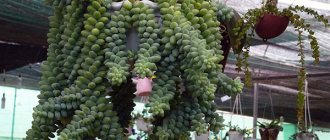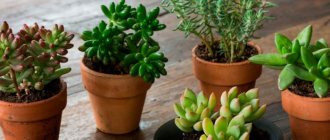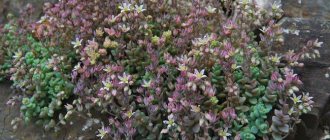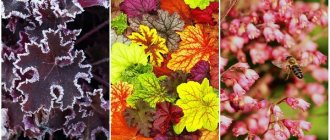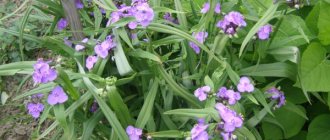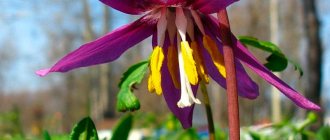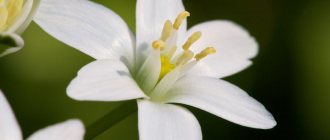Sedum is a decorative succulent that is widely in demand in the design of city flower beds, park areas and private gardens. In terms of ease of care and planting, this plant has few equals in ornamental gardening. Popularly, sedum grass is also called fever herb or hernia grass due to its healing properties, well known to herbal healers. There is a myth according to which the son of Hercules Telephos coped with a severe wound inflicted on him by the spear of Achilles, precisely with the help of sedum grass. The appearance of these flowers is simple and artless, but at the same time they elegantly and tactfully fit into a garden or park landscape, without preventing others from shining and taking their rightful place against their background.
General description with photo
Sedum or sedum is an unpretentious herbaceous succulent classified as a member of the Tolstyankov family. In nature, it is distributed on all continents except Australia and Antarctica. It can be found most often in sunny meadows and on poor soils of dry slopes. The lifespan of one plant for most representatives of the genus is about 5 years (relative long-livers are also found), but there are also varieties of a two-year development cycle. In terms of the shape of the bushes, numerous species and varieties of sedum can differ greatly from each other, which is typical for many succulents. Some of them form fairly tall bushes, others spread like groundcovers along the ground or form dense, medium-sized clumps.
The arrangement of leaves can also be different - alternate, opposite or whorled. The leaf blades themselves are sessile, fleshy, juicy, whole. The color changes not only in different varieties, but also in one type of sedum a gradual change in color can occur over the course of one growing season.
The sedum forms both lateral and apical inflorescences, often umbellate or corymbose, but sometimes racemose. In each of them, star-shaped buds of bisexual origin are found. The color of the inflorescences includes the entire palette of colors from light pink to muted burgundy tones. It can also be white, yellow, purple, orange or green. Flowering begins in mid-summer and continues until late autumn. Sedum is an excellent honey plant; its plantings attract bees to the site, which pollinate other cultivated fruit plants.
Close relatives of sedum are Kalanchoe and Echeveria.
What is important to know before purchasing sedum groundcover
For convenience, we have highlighted the most important points for the future owner of sedums:
| Mature plant size | from 5 to 30 cm in height |
| Lifespan | 5 years (requires regular updates) |
| Bloom | blooms in summer (flowers of different colors in the shape of a star) |
| Aroma | may have a strong spicy odor reminiscent of bird cherry |
| Safety | poisonous (gloves required when working) |
| Difficulty of care | unpretentious |
| Uniqueness | common type |
| Where can I buy |
|
Types and varieties of reports with names and photos
There are many varieties of sedum, and about a third of them are cultivated. Cold-resistant varieties and species are grown in garden plots and in city flower beds. As for tropical varieties, they have found their place in home floriculture.
Common Sedum
It is a medium-sized perennial up to 60 cm high. It has shortened roots and strong fleshy shoots with the same succulent foliage. The inflorescences are apical, multi-flowered, gradually changing color from green to muted pink, and then to purple-burgundy.
Sedum Caustic
A winter-hardy, unpretentious plant that can be found in the wild in Russia. The name “caustic” was given to it for a reason. The juice of plants of this species can corrode the skin to ulcers, so handling it requires special care. Low bushes are densely covered with leaves that do not fall off even in cold weather. It blooms with bright yellow small quinquefoil buds, forming a dense clump, painted in calm yellow-green tones.
Sedum False
Mountain variety with increased winter hardiness. Shoots of a horizontally ascending type, colored dark burgundy. Intertwined, they create a dense carpet of uneven height, blooming in purple-violet color. Forms corymbose-type inflorescences.
Sedum Vidny
This variety is native to eastern countries. The bushes are of medium height (about half a meter), the leaves are opposite, green in color with a slight bluish tint. Has many varieties that bloom in purple, violet and lilac tans. Based on this variety, many varietal lines have been developed. The most popular have become dark-flowered varieties and hybrids, for example, such as “Black Jack” or “Matrona” with dark purple shoots, the same color veining along the green leaf and inflorescences painted in purple tones.
Sedum Lydian
It is a very unpretentious ground cover with gray-green foliage that can take on a pink tint when grown in open, sunny areas. Blooms with pink buds.
Sedum White
Another ground cover variety that forms a dense covering carpet. When grown on fertile soil, it can behave aggressively, displacing neighboring plants. Star-shaped white-pinkish flowers bloom in large numbers on low peduncles, which the plant actively expels in mid-summer. With the onset of the first cold weather, the foliage begins to change color from green to purple, and in some varietal varieties, for example, the Murale variety, to purple.
Sedum Rocky (Bent)
A variety of original appearance, producing fluffy green shoots with fleshy, needle-like foliage. It forms small but very pretty curtains, from which tall peduncles with yellow buds grow.
Stonecrop Kamchatsky
It is distinguished by strong branching and has lanceolate-toothed foliage, the color of which depends on the variety. This species also has a variegated variegated variety.
Sedum Evers
A shrubby plant with woody shoots. The green leaf blades have a rounded shape. The paniculate-type inflorescences are very lush, quite dense, and harmoniously combine with oval foliage. Looks great in the design of garden paths, rock gardens and among decoratively laid stones.
Sedum Siebold
The shoots are ampel-type with a length of up to 25 cm. The foliage is painted in a very beautiful green-ash shade, which goes well with the pale lilac buds. Very attractive in appearance, but rather capricious in appearance. It does not retain its decorative effect for long.
Morgana sedum
Produces creeping shoots that can reach a meter in length. The leaves are rounded-pointed, small in size, alternate in arrangement. Due to their close growth and tight fit, the shoots look densely leafy. It blooms with red inflorescences and looks very impressive in hanging flowerpots.
Sedum thickleaf
An interesting semi-shrub variety with cylindrical leaves of a muted gray-green color. The tips of the leaves are bluntly rounded and gradually change their color to red. Blooms in yellow or green.
Sedum Spanish
The ground cover is bluish-green, turning to pink. The more sun this sedum receives, the more pink its curtain becomes. It has a tendency to actively self-sow, which is why it often poses a threat to the plantings of neighboring crops. The buds are painted white.
Sedum Multistem
It has an external resemblance to the Evers sedum, but does not grow to such sizes. Its height barely reaches 20 cm, and in dwarf varieties it is half as much. This variety of sedum is considered one of the most capricious in planting and care.
Difficulties in maintenance
To keep it decorative:
- You cannot use fresh organic matter;
- stems must be regularly shortened;
- you need to remove faded foliage and inflorescences;
- in case of disease (rainy, cold summer), plants are treated with fungicidal preparations.
Rock sedum is a very unpretentious plant that is easy to care for and even easier to propagate. Any gardener who has planted it at least once on his plot will want to continue to use sedum to decorate the landscape.
Planting and care
Sedum should be planted in open ground with ready-made seedlings in May, choosing more precise dates depending on the frost resistance of a particular variety. Most of them are not picky about weather conditions.
Choosing a landing site
It is better to choose an open place for planting sedums; they are not afraid of scorching heat, but a little shade will not interfere with their growth and flowering. They do not make great demands on the composition of the soil, but on humus soils the bushes turn out to be more lush.
It is undesirable to plant sedum under deciduous trees so that its autumn decorative effect is not damaged due to foliage falling on the flowerbed.
Sedum care
The planting scheme assumes a distance of approximately 20 cm between neighboring seedlings. This crop requires watering only in intense heat, but timely weeding will be necessary, since even species prone to invading neighboring territories do not resist the growth of weeds well. The exception is caustic sedum, which itself copes well with weeds.
To keep the curtain neat and even, it can be periodically trimmed using garden shears. Shortened stems quickly restore their green mass due to the active growth of side shoots. It is also advisable to promptly trim wilted leaves and inflorescences. If the species changes the color of its shoots and foliage throughout the season, then starting from the second half of summer, it is recommended to cut out all green shoots from growing bushes. The same goes for varieties with multi-colored stems.
For feeding, use either liquid organic matter (mullein 1:10 or a solution of bird droppings at 2 times lower concentration) or a mineral complex.
Fresh manure is not applied to this crop!
What shades do sedums bloom in?
This plant is often used in landscape design. For your convenience, we have grouped the species by flowering shades:
| Yellow-flowered | Aureum, Yellow Queen, Cape Blanco, Lemon Ball, Cristatum, Takahira Dake, Purpureum |
| White-flowered | Atropurpureum, Coral Carpet, Murale, lydium, Faro Form, Minus |
| Rosaceae | Fuldaglut, Roseum, Tricolor |
| Red-flowered | Purpurteppich, Bertram Anderson |
Sedum flowers
Wintering
Even winter-hardy species can be prepared for winter by pruning almost all shoots, with the exception of the 4-5 strongest ones. They should be covered with soil in winter. Trimmed stems are excellent planting material for propagation by cuttings. For the winter, they can be planted in a container with soil for rooting, storage in a cool room and subsequent replanting in the spring in open ground.
The pre-winter pruning procedure is not mandatory; you can leave the sedum uncut, especially since it retains its decorative effect for a long time even under the snow until it is completely covered with it. In this case, radical pruning in the spring will be required.
Useful properties of sedum
Undeservedly forgotten, sedum was once grown as a garden crop. For centuries until the beginning of the 20th century, it was difficult to imagine a farmstead in the southern regions without this wonderful plant.
Traditional healers used medicinal properties to make tinctures and powders:
- to lower blood pressure,
- in the treatment of colds,
- to combat infertility,
- as a sedative
- to cleanse the blood,
- to restore the body after illness,
- in the treatment of impotence.
Propagation by seeds
You can plant sedum in seedlings or plant by direct sowing in open ground. A special feature of this option is the artificial stratification of already planted seeds. After distributing them over the surface of the substrate, the container is covered with film and placed in a place with very low positive temperatures (refrigerator, cellar). After 2 weeks, you can move the container to a cool place. Over the next 2 weeks, the seedlings will begin to sprout.
Autumn planting of seeds is acceptable, but not in open ground, but in containers that will winter under the snow. In April they will also need to be brought indoors. After the seedlings emerge and a pair of leaves forms, it is necessary to pick them.
The described generative method of reproduction makes sense only for species-specific specimens. Varietal plants will not transmit their characteristic characteristics to their seeds.

